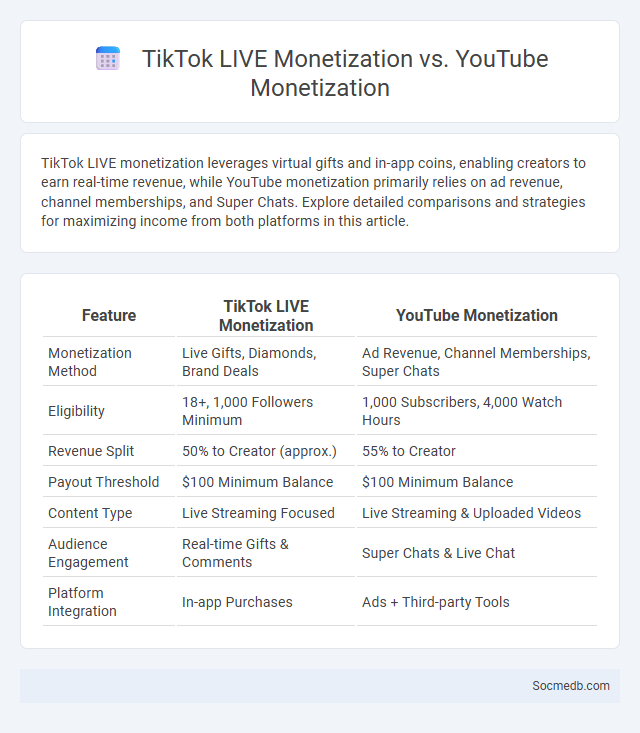
Photo illustration: TikTok LIVE Monetization vs YouTube Monetization
TikTok LIVE monetization leverages virtual gifts and in-app coins, enabling creators to earn real-time revenue, while YouTube monetization primarily relies on ad revenue, channel memberships, and Super Chats. Explore detailed comparisons and strategies for maximizing income from both platforms in this article.
Table of Comparison
| Feature | TikTok LIVE Monetization | YouTube Monetization |
|---|---|---|
| Monetization Method | Live Gifts, Diamonds, Brand Deals | Ad Revenue, Channel Memberships, Super Chats |
| Eligibility | 18+, 1,000 Followers Minimum | 1,000 Subscribers, 4,000 Watch Hours |
| Revenue Split | 50% to Creator (approx.) | 55% to Creator |
| Payout Threshold | $100 Minimum Balance | $100 Minimum Balance |
| Content Type | Live Streaming Focused | Live Streaming & Uploaded Videos |
| Audience Engagement | Real-time Gifts & Comments | Super Chats & Live Chat |
| Platform Integration | In-app Purchases | Ads + Third-party Tools |
Introduction to Livestream Monetization Platforms
Livestream monetization platforms enable content creators to earn revenue by broadcasting live video to their audience. These platforms offer various features like virtual tipping, paid subscriptions, and branded sponsorships to maximize income potential. Popular services such as Twitch, YouTube Live, and Facebook Gaming provide integrated tools for audience engagement and real-time analytics.
TikTok LIVE Monetization: Features and Requirements
TikTok LIVE monetization offers creators multiple revenue streams, including virtual gifts, coin purchases, and brand collaborations, enhancing your ability to earn directly from live broadcasts. Key requirements include maintaining a minimum follower count of 1,000 for gifting, being over 16 years old, and adhering to TikTok's community guidelines and content policies. Leveraging TikTok LIVE's interactive features can significantly boost engagement and increase your earning potential through real-time audience support.
YouTube Livestream Monetization: Features and Requirements
YouTube Livestream Monetization offers creators multiple revenue streams, including Super Chats, channel memberships, and ad revenue during live broadcasts. To qualify, your channel must have at least 1,000 subscribers, 4,000 public watch hours in the past 12 months, and must comply with YouTube's monetization policies. Enabling these features can significantly boost your earnings by engaging viewers in real-time and encouraging direct support during your live streams.
General Livestream Monetization: Methods and Opportunities
Livestream monetization offers diverse methods such as virtual gifting, subscription models, and real-time advertising integration, enabling creators to maximize earnings during live broadcasts. Platforms like Twitch, YouTube Live, and Facebook Gaming provide tailored tools that enhance viewer interaction and increase revenue streams by leveraging paid fan engagement. Your success in livestream monetization depends on consistently engaging your audience and strategically utilizing platform features to optimize earning potential.
Audience Engagement: TikTok LIVE vs YouTube vs Other Platforms
TikTok LIVE drives higher audience engagement rates through its interactive features like real-time comments, virtual gifts, and algorithm-driven content discovery, surpassing YouTube's traditional live streaming model. YouTube offers extensive monetization options and a robust search engine but often experiences slower viewer interaction compared to TikTok's immediacy. Other platforms like Twitch focus on niche communities and gaming content, generating deep engagement via chat and subscription models but lack TikTok's viral reach and YouTube's broad content diversity.
Revenue Streams Comparison: Gifts, Ads, Subscriptions, and More
Social media platforms generate revenue through various streams including gifts, ads, subscriptions, and more, each offering unique monetization opportunities. Gifts allow direct user contributions during live streams, while ads provide scalable income through targeted marketing, and subscriptions ensure consistent revenue via exclusive content access. Exploring these options helps you tailor your strategy for maximizing earnings and sustaining audience engagement.
Monetization Policies: TikTok LIVE vs YouTube Guidelines
TikTok LIVE monetization policies emphasize real-time interactions, enabling creators to receive virtual gifts from viewers, which can be converted into actual earnings, with specific thresholds for cashing out. YouTube's monetization guidelines focus on ad revenue, channel memberships, Super Chats, and merchandise shelf integration, requiring creators to meet the YouTube Partner Program criteria including a minimum of 1,000 subscribers and 4,000 watch hours in the past year. Both platforms enforce strict community guidelines and content standards to ensure compliance and eligibility for revenue generation, but YouTube offers a broader range of monetization tools beyond live streaming.
Platform Algorithm Impact on Livestream Earnings
Social media platform algorithms significantly influence livestream earnings by determining content visibility and audience engagement through personalized feeds and recommendation systems. Algorithms prioritize streams with higher viewer interaction metrics such as likes, comments, and shares, directly affecting ad revenue and virtual gifting potentials for creators. Understanding and optimizing content to align with algorithmic preferences enhances discoverability, driving greater monetization opportunities on platforms like Twitch, YouTube, and Facebook Live.
Creator Support and Analytics: Comparing Platform Tools
Creator support and analytics tools on social media platforms like Instagram, YouTube, and TikTok offer varying features tailored to content performance insights and audience engagement metrics. YouTube provides comprehensive analytics with real-time data on viewer demographics, watch time, and revenue estimations, while TikTok emphasizes trend tracking and engagement rate metrics to support viral content creation. Instagram's creator support includes detailed insights on follower growth and interaction rates, alongside monetization options such as branded content tools and shopping integrations.
Which Platform is Best for Livestream Monetization?
YouTube Live offers the most robust monetization options for livestreaming, including Super Chats, channel memberships, and ad revenue sharing. Twitch remains a top choice for gaming content creators, providing subscriptions, Bits, and sponsorships that directly support streamers. Facebook Live caters well to brands and influencers with in-stream ads, fan subscriptions, and Stars, making it effective for diverse audiences and interactive engagement.
 socmedb.com
socmedb.com